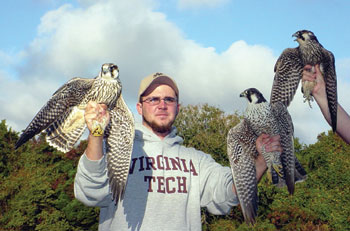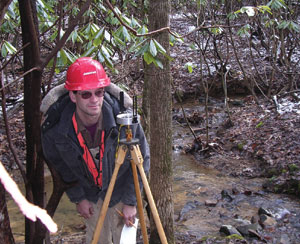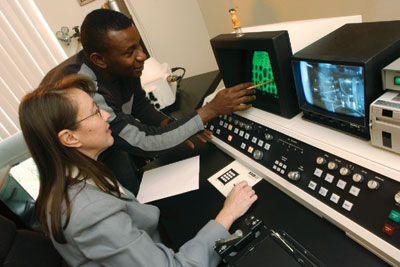|
 College of Natural Resources: Life lessons for tomorrow's leaders College of Natural Resources: Life lessons for tomorrow's leaders
by Lynn Davis
The College of Natural Resources (CONR) is about life. Whether through a world demographic study using satellite imagery, wildlife research that impacts human health, or the beauty and functionality of an urban forestry project, the college--the only one of its kind in Virginia--connects our environment to our lives.
Nationally recognized as a leader among peer institutions and internationally known for its outstanding undergraduate and graduate education, research, and outreach and Extension activities, the college's roots lie in a simple forestry course taught in 1902. The course was based on Gifford Pinchot's Primer of Forestry, which showcased Pinchot's research in the popular new field of forest management. In the 1920s, a public interest in conservation and a friendship between journalist and conservationist Ding Darling and biology Professor I.D. Willson helped secure the creation of one of the federal government's first Cooperative Wildlife Research Units at then-VPI. By 1938, students could earn a bachelor of science in conservation and forestry.
 The program continued to grow, eventually becoming the College of Forestry and Wildlife Sciences. Eight short years later, it became the College of Natural Resources, which today encompasses the departments of fisheries and wildlife sciences, forestry, geography, and wood science and forest products, as well as Virginia's Water Resources Research Center. Professors engage in substantial research, with funding expenditures per faculty member among the university's highest. The program continued to grow, eventually becoming the College of Forestry and Wildlife Sciences. Eight short years later, it became the College of Natural Resources, which today encompasses the departments of fisheries and wildlife sciences, forestry, geography, and wood science and forest products, as well as Virginia's Water Resources Research Center. Professors engage in substantial research, with funding expenditures per faculty member among the university's highest.
A survey of assistant forestry professors across the nation revealed the breadth of the college's impact on education--more of the respondents came from Virginia Tech than any other university. Undergraduate and graduate students have numerous opportunities to participate in the college's extensive research, outreach activities, and study-abroad programs. One example is the Conservation Management Institute, which has established research programs in Peru, Nepal, Egypt, Nicaragua, Panama, Mexico, and Belize. Also, one of the college's most popular outreach programs is Audrey Zink-Sharp's Wood Magic Show, a fun-filled day during which kids learn about wood science in hands-on demonstrations.
Today, the college is continuing its decades-long tradition of expansion and recognition. The National Capital Region Program in Washington, D.C., is seeing substantial growth in the new master's degree program under David Trauger. Jim Johnson, who oversees CONR's robust Cooperative Extension (which includes 20 faculty and specialist positions) and outreach activities, was awarded the Society of American Foresters (SAF) 2005 Technology Transfer Award. SAF also recognized the college's student members with the 2005 Student Chapter of the Year Award.
Not the least of the college's distinctions are its alumni, many of whom head up state and national natural resource agencies. Two of these shining alums are Ed Knipling (forestry and wildlife '61), who serves as the USDA’s Agricultural Research Service administrator, and Carl Garrison (forestry and wildlife '78), state forester for Virginia.
Today's College of Natural Resources, says Dean Mike Kelly, "is continually re-positioning itself to respond to society's evolving needs for educated natural resource managers and the tools to manage effectively."
 Lynn Davis is the communications manager for the College of Natural Resources. Lynn Davis is the communications manager for the College of Natural Resources.
|

|
|
|
|
Research distinctions mark the college
The College of Natural Resources is a world leader not only in training future generations of natural resource managers, but also in providing research critical to knowing how to use and preserve the resources here and beyond.
World-renowned polymer chemist Wolfgang Glasser, who holds more than 15 patents, received the American Chemical Society's rarely conferred Anselme Payen Award.
Eric Hallerman, a fish geneticist and patent holder who focuses on conservation and biotechnology in aquaculture, also serves as director of the Virginia Tech Horseshoe Crab Research Center (designated by the federal government as its prime facility for horseshoe crab research) and on the prestigious National Research Council's Standing Committee on Biotechnology, Food and Fiber Production, and the Environment.
Marcella Kelly, an internationally known wildlife scientist who focuses on carnivore ecology and population ecology, employed her own remote camera research techniques to provide rare photos of African wildlife for a 2005 National Geographic feature story.
Highly regarded as a freshwater mussel conservationist and biologist worldwide, Dick Neves was honored by The Nature Conservancy and also given the highest award issued by the U.S. Geological Survey.
Joe Scarpaci, an expert on Cuba's landscape architecture and author of many books on social geography issues in the Caribbean, has received numerous top professional awards, including the Carl O. Sauer Distinguished Scholarship Award from the Conference of Latin Americanist Geographers.
Mike Vaughan, an authority on best management practices within wildlife science, was recently featured in a National Geographic article on his review of flawed research on the endangered Florida panther. Vaughan, known around the world for his long-term studies on black bear reproduction, has uncovered research that could lead to advances in human medicine.
University Distinguished Professor Harold Burkhart wrote the seminal textbook on forestry biometerics and is the world's pioneer in that field.
John Seiler, who developed the world's most comprehensive tree identification CD and online teaching module, has received a host of teaching awards, including the country's top forestry teaching award.
Jim Campbell, a nationally recognized expert on geospatial analysis using remote sensing and photogrammetry techniques, authored Introduction to Remote Sensing, one of the most widely used texts within university-level remote sensing courses. He received the Virginia Outstanding Scholar in Geography Award in 2005.
Attorney and forestry professor Mike Mortimer is one of the nation's top experts in public land law and management, forest regulation, and environmental and natural resource conflict. The Society of American Foresters recognized him with the 2005 Young Forester Leadership Award.
Earl Kline, a key player in the national Sloan Forest Industries Center based at Virginia Tech, researches innovative ways to keep America's forest products companies in business despite tough global competition.
Wood products scientist Joe Loferski has written building codes to make wooden decks safer after his research revealed the flaws that cause decks to collapse.
Mark White directs the world's only pallet research lab and works with manufacturers to custom-make pallets that suit specific needs.
By applying genetics to forestry practices, Amy Brunner and Ulrika Egertsdotter hope to improve tree management. One example is manipulating the gene that monitors a tree's breeding cycle.
Steve Prisley and Randy Wynne, experts in natural resources geomatics (collection and analysis of map/spatial data), perform quantitative and spatial analyses of forest resources for strategic and tactical forest management planning.
Maren Roman, who studies natural and bio-based polymers and composites, is investigating the properties and applications of cellulose nanocrystals.
Sustainable Engineered Materials Institute Director Audrey Zink-Sharp studies wood cell wall architecture to develop better wood-based composites.
|
|

 The program continued to grow, eventually becoming the College of Forestry and Wildlife Sciences. Eight short years later, it became the College of Natural Resources, which today encompasses the departments of fisheries and wildlife sciences, forestry, geography, and wood science and forest products, as well as Virginia's Water Resources Research Center. Professors engage in substantial research, with funding expenditures per faculty member among the university's highest.
The program continued to grow, eventually becoming the College of Forestry and Wildlife Sciences. Eight short years later, it became the College of Natural Resources, which today encompasses the departments of fisheries and wildlife sciences, forestry, geography, and wood science and forest products, as well as Virginia's Water Resources Research Center. Professors engage in substantial research, with funding expenditures per faculty member among the university's highest.

